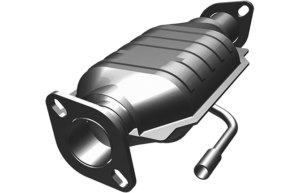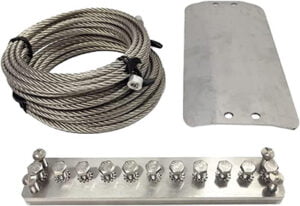Introduction
The Soaring Numbers: Unmasking the Epidemic of Catalytic Converter Thefts
The catalytic converter theft epidemic, while staggering, exhibits a complex narrative when we delve into the recent statistics. According to BeenVerified, there were more than 26,000 reported catalytic converter thefts in the U.S. during the first six months of 2023. While this figure is undeniably high, it marks a notable 43% decrease compared to the same period in 2022. However, the cautionary note emerges as we recognize that despite this decrease, catalytic converter thefts remain 21% higher than the figures reported four years ago.
 This nuanced perspective sheds light on the dynamic nature of the issue. While recent efforts may have contributed to a decline in reported thefts, the overall trajectory reveals a persistent and concerning upward trend over the past four years. Understanding both the short-term improvements and the long-term challenges is essential as we navigate through the motives, consequences, and protective measures associated with catalytic converter thefts.
This nuanced perspective sheds light on the dynamic nature of the issue. While recent efforts may have contributed to a decline in reported thefts, the overall trajectory reveals a persistent and concerning upward trend over the past four years. Understanding both the short-term improvements and the long-term challenges is essential as we navigate through the motives, consequences, and protective measures associated with catalytic converter thefts.
In the subsequent sections, we will explore the motives driving this criminal enterprise, unravel the economic incentives and illicit markets at play, and discuss protective measures to mitigate the impact. By incorporating these statistics into the narrative, we aim to provide readers with a comprehensive understanding of the catalytic converter theft epidemic, fostering informed discussions on strategies to address both immediate and long-term concerns.
Motives Behind Catalytic Converter Theft
The surge in catalytic converter thefts is not merely a random spate of criminal activity but is deeply rooted in distinct motives that drive perpetrators to target these vehicle components. Understanding these motives is crucial for developing effective countermeasures against this pervasive and lucrative criminal enterprise.
Economic Incentives: At the heart of catalytic converter theft lies a compelling economic motive. These components house precious metals such as platinum, palladium, and rhodium, which hold significant value in the illicit market. As global demand for these metals increases, so does their black-market value, providing a lucrative opportunity for criminals seeking quick financial gains.
Accessibility and Vulnerability: Catalytic converters are often situated underneath vehicles, making them easily accessible targets for thieves. Their relative vulnerability, coupled with the speed at which these thefts can be executed, further amplifies their appeal to criminals seeking swift and discreet operations. The ease of removal contributes to the prevalence of these thefts across various regions.
Lax Regulatory Oversight: The lack of stringent regulations around the sale and purchase of catalytic converters contributes to the thriving black market for stolen units. With minimal oversight, criminals can offload stolen converters without significant scrutiny, creating a clandestine network that perpetuates the cycle of theft.
Global Demand for Precious Metals: As industrial and technological advancements drive the global demand for precious metals, catalytic converters become prime targets. The metals within these components play a crucial role in various industries, from automotive to electronics. This high demand ensures a consistent market for stolen catalytic converters.
Repeat Offenses and Organized Crime: Catalytic converter thefts often exhibit patterns of repeat offenses, indicating organized and systematic criminal involvement. Organized crime groups recognize the potential for continuous financial gains, leading to strategic and coordinated efforts to target specific areas and vehicle types.
The Fate of Stolen Converters
Once wrenched from their rightful vehicles, stolen catalytic converters embark on a clandestine journey within the underbelly of the criminal underworld. Understanding the fate of these purloined components unveils a web of illicit activities that sustain this lucrative black market.
Black Market Transactions: Stolen catalytic converters often find their way into the hands of black-market operators who specialize in the trade of precious metals. The illicit transactions occur discreetly, facilitated by a network of individuals willing to purchase these stolen components without asking too many questions. The lack of stringent regulations around catalytic converter sales contributes to the ease with which criminals can offload their ill-gotten gains.
 Precious Metal Extraction: The true value of catalytic converters lies in the precious metals they house – platinum, palladium, and rhodium. Once in the possession of criminals, these converters undergo a process of dismantling, wherein the valuable metals are extracted. This extraction is often performed in makeshift operations that prioritize speed and efficiency over environmental and safety considerations.
Precious Metal Extraction: The true value of catalytic converters lies in the precious metals they house – platinum, palladium, and rhodium. Once in the possession of criminals, these converters undergo a process of dismantling, wherein the valuable metals are extracted. This extraction is often performed in makeshift operations that prioritize speed and efficiency over environmental and safety considerations.
Smelting and Recycling Facilities: Stolen catalytic converters may find their way to smelting and recycling facilities that operate with lax oversight. Here, the extracted precious metals are melted down and incorporated into new materials, making it challenging to trace their origin. The involvement of these facilities in processing stolen metals contributes to the perpetuation of catalytic converter thefts.
Overseas Export: In some cases, stolen catalytic converters may be exported overseas to regions with less stringent regulations on the trade of precious metals. The global nature of the black market allows for the seamless movement of stolen goods, making it difficult for law enforcement to track and intercept these illicit shipments.
Cyclical Nature of Theft: The successful conversion of stolen catalytic converters into monetary gains perpetuates a cyclical pattern. The economic incentives driving thefts lead to repeat offenses, with organized crime groups strategically targeting areas and vehicle types to maximize their illicit gains.
Vehicles Most at Risk for Catalytic Converter Theft
Catalytic converter thieves display a discerning eye when it comes to selecting their targets, favoring specific vehicles that align with their illicit objectives. Understanding the patterns and characteristics of vehicles most at risk provides valuable insights for vehicle owners seeking to fortify their defenses against this pervasive threat.
High Ground Clearance: Vehicles with high ground clearance, such as SUVs and trucks, are particularly susceptible to catalytic converter thefts. The elevated undercarriage provides ample space for thieves to operate discreetly and swiftly, making these vehicles prime targets. Additionally, the accessibility of the catalytic converter in such vehicles adds to their vulnerability.
Hybrid Vehicles: Hybrid vehicles, known for their environmentally friendly features, often house catalytic converters with a higher concentration of precious metals. This heightened value makes them attractive targets for thieves looking to maximize their illicit gains. The unique design of hybrid converters may also contribute to the appeal, as they differ from traditional converters found in combustion engine vehicles.
Park and Ride Facilities: Locations where vehicles are parked for extended periods, such as park and ride facilities or long-term parking lots, become hotspots for catalytic converter thefts. The reduced likelihood of immediate detection in these areas provides thieves with the time and seclusion needed to carry out their operations efficiently.
Commercial Vehicles: Commercial vehicles, including vans and delivery trucks, often fall prey to catalytic converter thefts due to their widespread use and frequent parking in various locations. Thieves target these vehicles for their potentially higher yields of precious metals, escalating the financial incentives associated with their theft.
Residential Areas with Limited Surveillance: Residential neighborhoods with limited surveillance and low visibility become attractive hunting grounds for catalytic converter thieves. The combination of less scrutiny, ample parking spaces, and the potential for undisturbed operations creates an environment conducive to swift thefts.
Strategic Targeting of Specific Models: Certain vehicle models exhibit a higher susceptibility to catalytic converter thefts, often due to the design of their catalytic converters or the ease with which they can be accessed. Thieves may strategically target specific makes and models to streamline their operations and maximize their gains.

The Financial Toll: Counting the Costs of Catalytic Converter Theft
The aftermath of a catalytic converter theft extends far beyond the immediate shock and inconvenience, as victims find themselves grappling with a substantial financial toll. Understanding the economic implications sheds light on the true impact of these thefts on individuals and communities.
Cost of Replacement: The most immediate and tangible expense for victims of catalytic converter theft is the cost of replacement. Catalytic converters are integral components of a vehicle’s emissions control system, and their absence renders the vehicle inoperable. The expense of acquiring a new catalytic converter, coupled with installation costs, can range from hundreds to thousands of dollars, depending on the vehicle make and model.
Here are some approximate price ranges:
Standard Aftermarket Converters:
- $100 to $500
OEM (Original Equipment Manufacturer) Converters:
- $300 to $1,000 or more
High-Performance or Specialty Converters:
- $500 to $2,500 or more
Insurance Premiums and Deductibles: Victims often turn to their insurance policies to mitigate the financial burden of catalytic converter theft. However, filing a claim can lead to increased insurance premiums, potentially over an extended period. Additionally, policy deductibles contribute to the out-of-pocket costs borne by the victim, further amplifying the financial strain.
Loss of Use and Productivity: During the time a vehicle remains inoperable due to catalytic converter theft, owners may incur indirect costs associated with the loss of use and productivity. For individuals reliant on their vehicles for daily commuting or business purposes, the disruption can lead to missed workdays, canceled appointments, and decreased productivity, all of which contribute to financial setbacks.
Increased Vulnerability to Subsequent Thefts: Once targeted, victims may become more susceptible to future catalytic converter thefts. Criminals often recognize that a previously stolen converter has been replaced, potentially leading to repeat offenses. The cycle of theft and replacement can compound the financial toll on individuals, creating a recurring burden.
Community Impact: Catalytic converter thefts extend beyond individual victims, impacting communities at large. Businesses relying on a fleet of vehicles may face operational disruptions and increased costs. Moreover, neighborhoods experiencing a surge in catalytic converter thefts may witness a decline in property values and a sense of insecurity, affecting the overall financial well-being of the community.
Safeguarding Your Vehicle: Fortifying Defenses Against Catalytic Converter Theft
Taking proactive measures to safeguard your vehicle against catalytic converter theft is essential in mitigating the risk of falling victim to this pervasive criminal activity. Here are effective strategies to fortify your defenses:
1. Catalytic Converter Protection Devices:
- Install catalytic converter protection devices, such as shields, cages, or clamps, designed to deter thieves. These physical barriers make it more challenging for criminals to access and remove the converter quickly.
2. Parking in Well-Lit Areas:
- Park your vehicle in well-lit and populated areas. Thieves are less likely to target vehicles in locations with high visibility, reducing the likelihood of undetected theft.
3. Utilize Secure Parking Facilities:
- Opt for secure parking facilities with surveillance cameras and controlled access. Garage parking or monitored lots add an extra layer of security, making it less appealing for thieves.
4. Engrave Your VIN or Unique Identifier:
- Engrave your vehicle identification number (VIN) or a unique identifier onto the catalytic converter. This makes it easier for law enforcement to trace stolen converters and may act as a deterrent for thieves.
5. Install Motion-Activated Lights:
- Motion-activated lights can startle potential thieves and draw attention to suspicious activity around your vehicle. Install these lights in your driveway or parking area for added security.
6. Consider Catalytic Converter Marking Systems:
- Some marking systems involve applying a unique identifier or marking to the catalytic converter, making it easier to trace and identify stolen units. Check with local law enforcement or auto security professionals for available marking options.
7. Work with Your Mechanic:
- Consult with your mechanic about installing anti-theft devices or reinforcing the mounting of the catalytic converter. They may offer additional recommendations based on your specific vehicle model.
8. Community Awareness:
- Raise awareness about catalytic converter theft within your community. Share information about recent incidents, preventive measures, and encourage neighbors to be vigilant and report suspicious activity.
9. Invest in Security Cameras:
- Install security cameras around your property, especially in areas where your vehicle is parked. Visible cameras act as a deterrent and provide valuable evidence in the event of a theft.
10. Be Cautious of Unusually Low Repair Offers:
- When replacing a catalytic converter, be cautious of unusually low repair offers. Thieves may pose as mechanics offering inexpensive replacements, only to steal the new converter shortly after installation.


